双向链表
WARNING
如果对链表不熟悉,请移步上一节,先学习单向链表
简介
- 双向链表:既可以从头遍历到尾,又可以从尾遍历到头。即链表连接的过程是双向的
- 实现原理:一个节点既有向前连接的引用,也有一个向后连接的引用
缺点
- 每次在插入或删除某个节点时,都需要处理四个引用,而不是两个,实现起来会困难些
- 相对于单向链表,所占内存空间更大一些
- 但是,相对于双向链表的便利性而言,这些缺点可以忽略
基本特点
- 双向链表有两个指针:head 指针指向头部第一个节点,tail 指针指向尾部最后一个节点
- 每个节点由三部分组成:前一个节点的指针(prev)、保存的数据(item)、后一个节点的指针(next)
- 双向链表的第一个节点的 prev 指向 null;
- 双向链表的最后一个节点的 next 指向 null;
结构图例
(1) 横向图例:

(2) 纵向图例:

常用操作
- append(element):向链表尾部添加一个新的项
- insert(position, element):向链表的特定位置插入一个新的项
- get(position):获取对应位置的元素
- indexOf(element):返回元素在链表中的索引。如果链表中没有该元素就返回-1
- update(position, element):修改某个位置的元素
- removeAt(position):从链表的特定位置移除一项
- remove(element):从链表中移除一项
- isEmpty():如果链表中不包含任何元素,返回 true,如果链表长度大于 0,返回 false
- size():返回链表包含的元素个数,与数组的 length 属性类似
- toString():由于链表项使用了 Node 类,就需要重写继承自 JS 对象默认的 toString 方法,让其只输出元素的值
- forwardString():返回正向遍历节点字符串形式
- backwordString():返回反向遍历的节点的字符串形式
代码实现
0、创建双向链表类
// 创建双向链表的构造函数
function DoubleLinkList() {
// 内部类:节点类
function Node(data) {
this.data = data
this.prev = null
this.next = null
}
// 属性
this.head = null // 用于指向第一个节点
this.tail = null // 用于指向最后一个节点
this.length = 0 // 记录长度
}
1、toString、forwardString、backwardString 方法
// 1. 将链表转存字符串形式
// 1.1 toString方法-从前往后遍历
DoubleLinkList.prototype.toString = function () {
return this.backwardString()
}
// 1.2 forwardString方法: 返回向前遍历节点字符串形式
DoubleLinkList.prototype.forwardString = function () {
// (1) 定义变量
var current = this.tail
var resultString = ""
// (2) 依次向前遍历,获取每一个节点
while (current) {
resultString += current.data + " "
current = current.prev
}
return resultString
}
// 2.3 backwardString方法: 返回向后遍历的节点的字符串形式
DoubleLinkList.prototype.backwardString = function () {
// (1) 定义变量
var current = this.head
var resultString = ""
// (2) 依次向后遍历,获取每一个节点
while (current) {
resultString += current.data + " "
current = current.next
}
return resultString
}
2、append 方法
// 2. append方法
DoubleLinkList.prototype.append = function (data) {
// 2.1 根据元素创建节点
var newNode = new Node(data)
// 2、判断是否为第一个节点
if (this.head == null) {
// 情况1:添加的是第一个节点
this.head = newNode
this.tail = newNode
} else {
// 情况2:添加的不是第一个节点
newNode.prev = this.tail // 新节点prev指向当前最后一个
this.tail.next = newNode // 当前最后一个节点的next指向新节点
this.tail = newNode // 改变最后一个节点
}
// 2.3 length+1
this.length++
}
过程详解-情况 1:第一个节点
- 只需要让 head 和 tail 都指向新节点即可
过程详解-情况 2:不是第一个节点
- 通过:newNode.prev = this.tail:建立指向 1
- 通过:this.tail.next = newNode:建立指向 2
- 通过:this.tail = newNode:建立指向 3
- 注意最后修改 tail 指向,在未修改前 tail 始终指向原链表的最后一个节点

测试代码:
// 1.创建双向链表对象
var list = new DoubleLinkList()
// 2.测试append方法:追加元素
list.append("aaa")
list.append("bbb")
list.append("ccc")
console.log(list)
// 3.测试字符串方法
console.log(list.forwardString()) // ccc bbb aaa
console.log(list.backwardString()) // aaa bbb ccc
console.log(list.toString()) // aaa bbb ccc
测试结果:
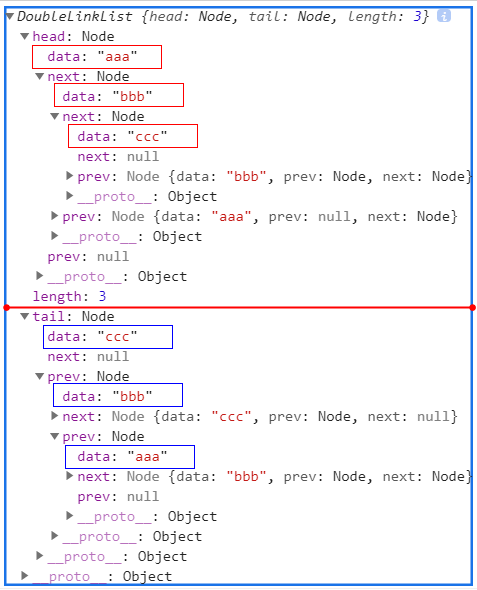
3、insert 方法
// 3. insert方法:向特定位置插入一个新的数据
DoubleLinkList.prototype.insert = function (position, data) {
// 3.1 边界判断
if (position < 0 || position > this.length) return false
// 3.2 根据data创建新的节点
var newNode = new Node(data)
// 3.4 判断原来的列表是否为空
if (this.length == 0) {
// 情况1:原链表为空,插入的newNode是第一个节点
this.head = newNode
this.tail = newNode
} else {
// 已有节点分多钟情况
if (position == 0) {
// 情况2:position == 0,插入第一个
this.head.prev = newNode
newNode.next = this.head
this.head = newNode
} else if (position == this.length) {
// 情况3:position == this.length,插入最后一个
newNode.prev = this.tail
this.tail.next = newNode
this.tail = newNode
} else {
// 情况4:0 < position < this.length,插入中间
var current = this.head
var index = 0
while (index++ < position) {
current = current.next
}
// 修改position位置前后节点的指针的指向
newNode.next = current
newNode.prev = current.prev
current.prev.next = newNode
current.prev = newNode
}
}
// 3.5 length +1
this.length += 1
// 返回插入成功
return true
}
过程详解-当原链表为空时
- 情况 1:插入的新节点是链表的第一个节点;只需要让 head 和 tail 都指向 newNode 即可
过程详解-当原链表不为空时
- 情况 2:当 position == 0,即在链表的首部添加节点,如下图所示:
- 首先,通过:this.head.prev = newNode,改变指向 1
- 然后,通过:newNode.next = this.head,改变指向 2
- 最后,通过:this.head = newNode,改变指向 3
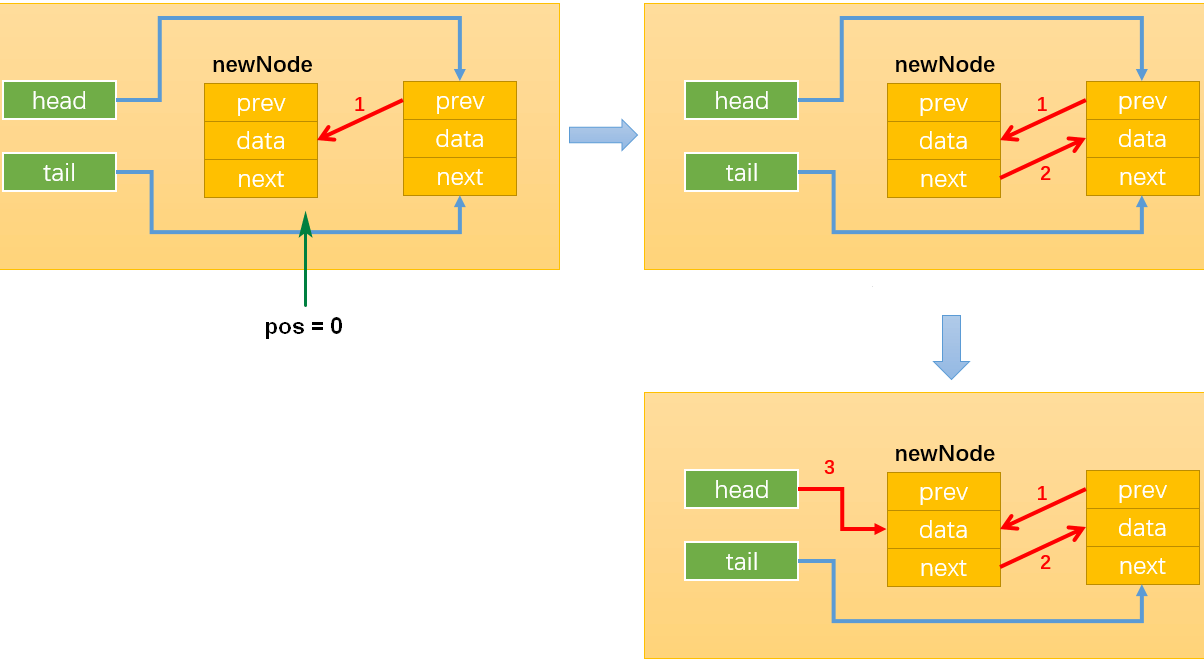
- 情况 3:position == this.length,即在链表的尾部添加节点,如下图所示:
- 首先,通过:this.tail.next = newNode,改变指向 1;(注意这里使用 this.tail 指向原链表最后一个节点,而不是 this.head。因为当 length>1 时,this.head != this.tail)
- 然后,通过:newNode.prev = this.tail,改变指向 2
- 最后,通过:this.tail = newNode,改变指向 3
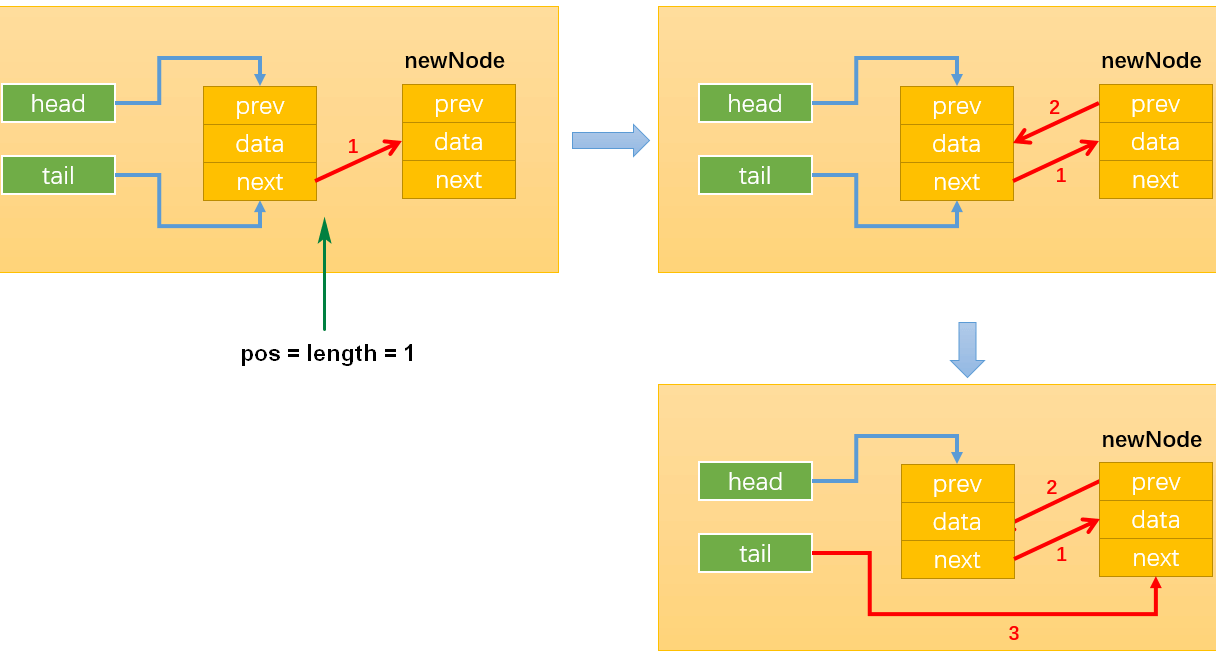
- 情况 4:0 < position < this.length,即在链表的中间插入新节点,假设在 position = 1 的位置插入,如下图所示:
- newNode.next = current,改变指向 1
- newNode.prev = current.prev,改变指向 2
- current.prev.next = newNode,改变指向 3
- current.prev = current,改变指向 4,(注意必须最后才修改 current.prev 的指向,不然就无法通过 current.prev 获取需要操作的 Node1 了)
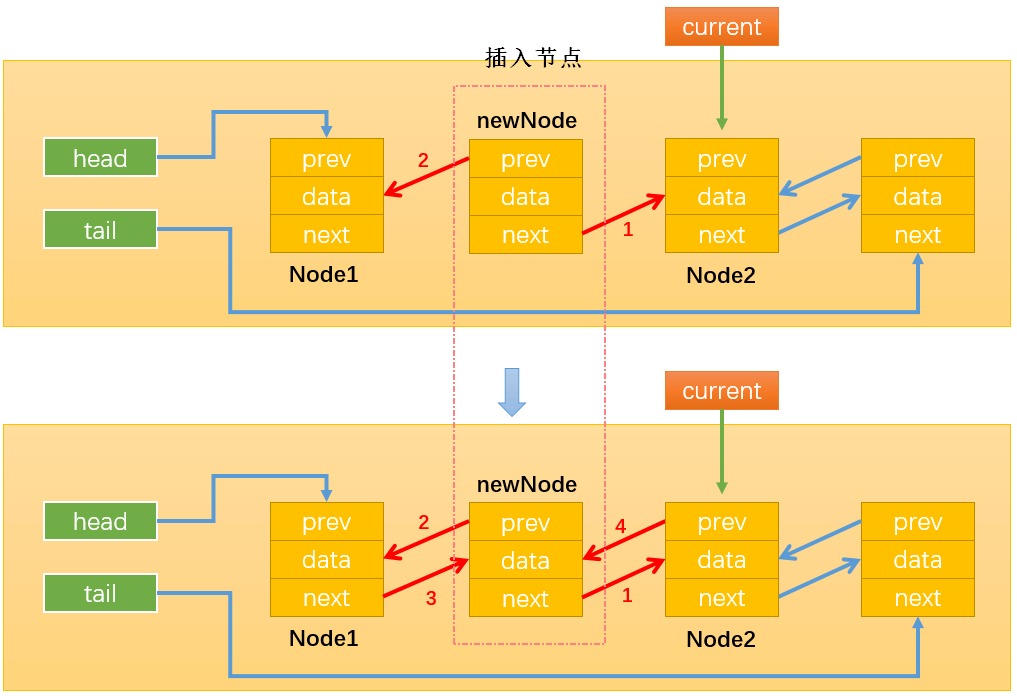
测试代码:
// 已有:aaa bbb ccc
list.insert(0, "100") // 首部插入
list.insert(2, "200") // 中间插入
list.insert(5, "300") // 尾部插入
console.log(list.toString()) // 100 aaa 200 bbb ccc 300
4、get 方法
// 4. get方法:获取对应位置的元素
DoubleLinkList.prototype.get = function (position) {
// 4.1 越界判断
if (position < 0 || position >= this.length) return null
// 4.2 获取元素
/*
方法一:一次查找,效率不是很高
var current = this.head
var index = 0
while (index++ < position) {
current = current.next
}
*/
/* 方法二:二分查找 */
var current = null
var index = 0
// this.length / 2 > position:从头开始遍历
if (this.length / 2 > position) {
current = this.head
while (index++ < position) {
current = current.next
}
} else {
// this.length / 2 <= position: 从尾开始遍历
current = this.tail
index = this.length - 1
while (index-- > position) {
current = current.prev
}
}
// 4.3 返回对应data
return current.data
}
过程详解
- 方法一:效率一般:定义两个变量 current 和 index,通过 while 循环遍历分别获取当前的节点和对应的索引值 index,一直找到需要获取的 position 位置的最后一个节点,此时 index = pos = x,然后 return current.data 即可
- 方法二:二分查找,效率高:通过 this.length / 2 与 position 的大小来判断
- 如果 this.length / 2 > position:从头(head)开始遍历
- 如果 this.length / 2 < position:从尾(tail)开始遍历
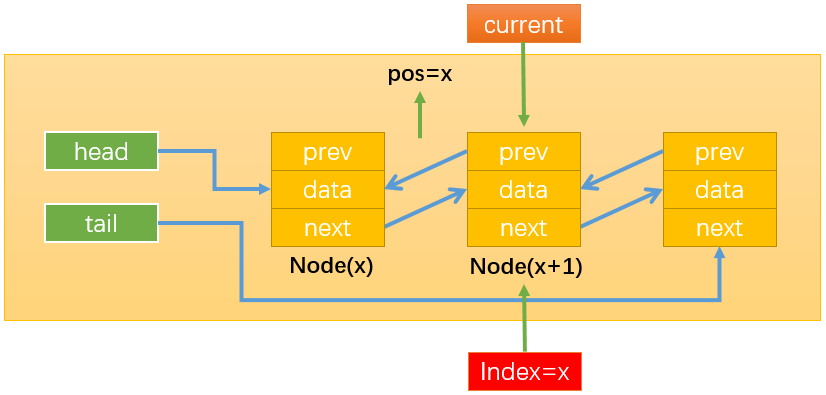
测试代码
// 已有:100 aaa 200 bbb ccc 300
console.log(list.get(0)) // 100
console.log(list.get(2)) // 200
console.log(list.get(5)) // 300
5、indexOf 方法
// 5. indexOf方法:返回元素在列表中的索引,如果列表中没有该元素则返回-1
DoubleLinkList.prototype.indexOf = function (data) {
// 5.1 定义变量
var current = this.head
var index = 0
// 5.2 查找和data相同的节点
while (current) {
if (current.data == data) {
return index
}
current = current.next
index += 1
}
// 5.3 查找到最后也没找到对应的元素,返回-1
return -1
}
过程详解
- 以(current)作为条件,通过 while 循环遍历链表中的所有节点(停止条件为 current = null)。在遍历每个节点时将 current 指向的当前节点的 data 和传入的 data 进行比较即可
测试代码
// 已有:100 aaa 200 bbb ccc 300
console.log(list.indexOf("100")) // 0
console.log(list.indexOf("200")) // 2
console.log(list.indexOf("300")) // 5
6、update 方法
// 6. update方法:修改某个位置的元素
DoubleLinkList.prototype.update = function (position, newData) {
// 6.1 越界判断
if (position < 0 || position >= this.length) return false
// 6.2 查找正确的节点
var current = this.head
var index = 0
// 这里使用依次循环遍历,也可以使用二分查找
while (index++ < position) {
current = current.next
}
// 6.3 修改找到节点的data信息
current.data = newData
return true
}
测试代码
// 已有:100 aaa 200 bbb ccc 300
list.update(0, "mmm")
list.update(2, "nnn")
console.log(list.toString()) // mmm aaa nnn bbb ccc 300
7、removeAt 方法
// 7. removeAt方法:从特定位置移除一项
DoubleLinkList.prototype.removeAt = function (position) {
// 7.1 越界判断
if (position < 0 || position >= this.length) return null
// 7.2 判断是否只有一个节点
// 定义在最上面方便以下各种情况返回current.data
var current = this.head
if (this.length === 1) {
// 情况1:表只有一个节点
this.head = null
this.tail = null
} else {
// 链表节点不止一个的情况
if (position === 0) {
// 情况2:删除第一个节点
this.head.next.prev = null
this.head = this.head.next
} else if (position === this.length - 1) {
// 情况3:删除最后一个节点
// 先获取引用,该情况下返回被删除的最后一个节点
current = this.tail
// 再改变指针
this.tail.prev.next = null
this.tail = this.tail.prev
} else {
// 情况4:删除链表中间的节点
var index = 0
while (index++ < position) {
current = current.next
}
current.prev.next = current.next
current.next.prev = current.prev
}
}
// 7.3 length - 1
this.length -= 1
// 7.4 返回被删除节点的数据
return current.data
}
过程详解-当链表的 length = 1 时
- 情况 1:删除链表中的所有节点:只需要让链表的 head 和 tail 指向 null 即可

过程详解-当链表的 length > 1 时
- 情况 2:删除链表中的第一个节点
- 首先,this.head.next.prev = null,改变指向 1
- 然后,this.head = this.head.next,改变指向 2
- 注意:虽然 Node1 有引用指向其它节点,但是没有引用指向 Node1,那么 Node1 会被自动回收
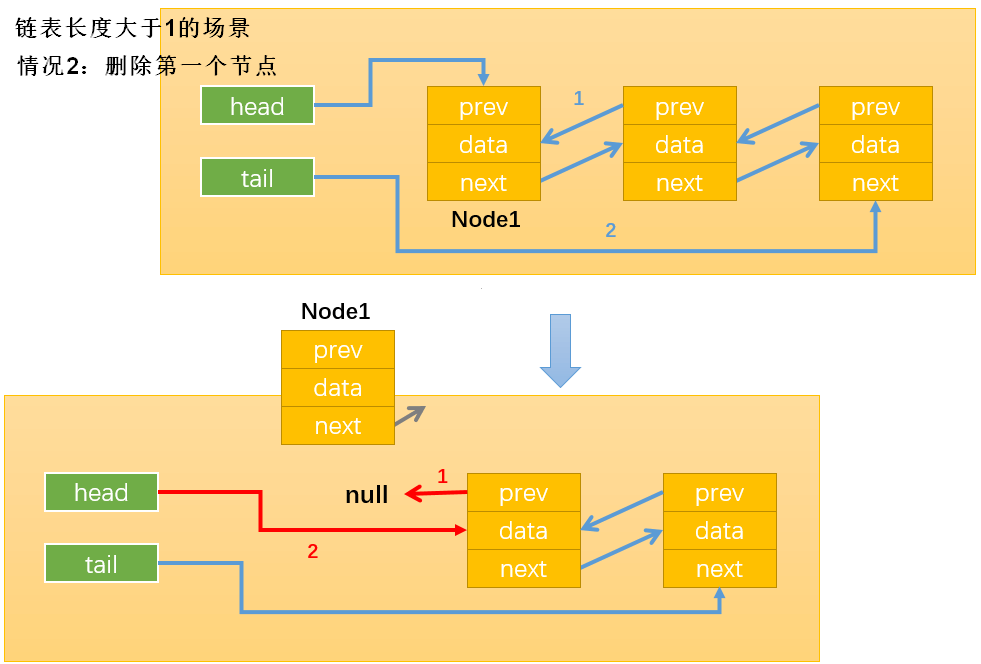
- 情况 3:删除链表中的最后一个节点
- 首先,this.tail.prev.next = null,修改指向 1
- 然后,this.tail = this.tail.prev,修改指向 2
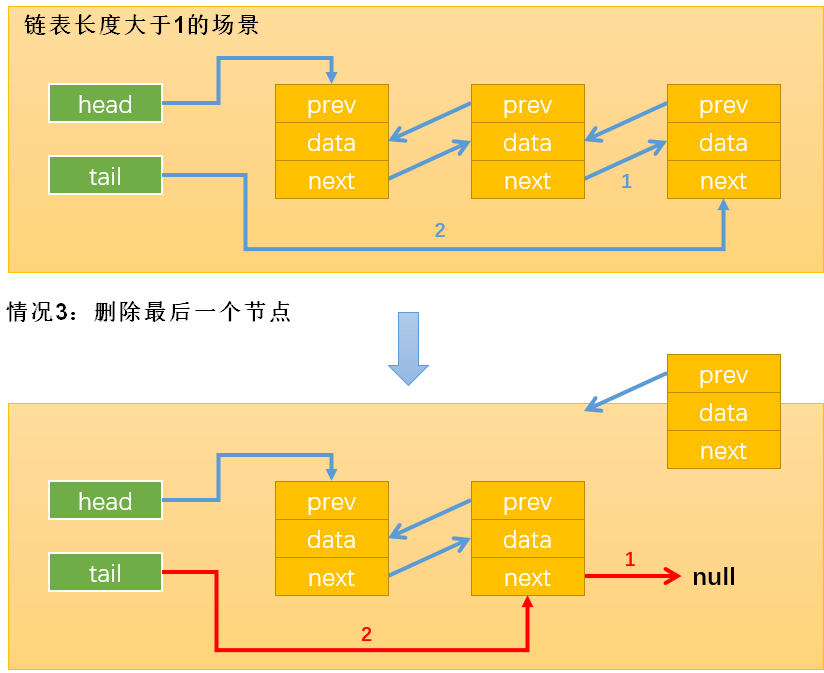
- 情况 4:删除链表中间的节点
- 通过 while 循环找到需要删除的节点,比如 position = x,那么需要删除的节点就是 Node(x+1),如下图所示:
- 通过:current.next.prev = current.prev,修改指向 1
- 通过:current.prev.next = current.next,修改指向 2
- 这样就没有引用指向 Node(x+1)了(current 虽指向 Node(x+1),但 current 时临时变量,该方法执行完就会被销毁),随后 Node(x+1)就会被自动删除
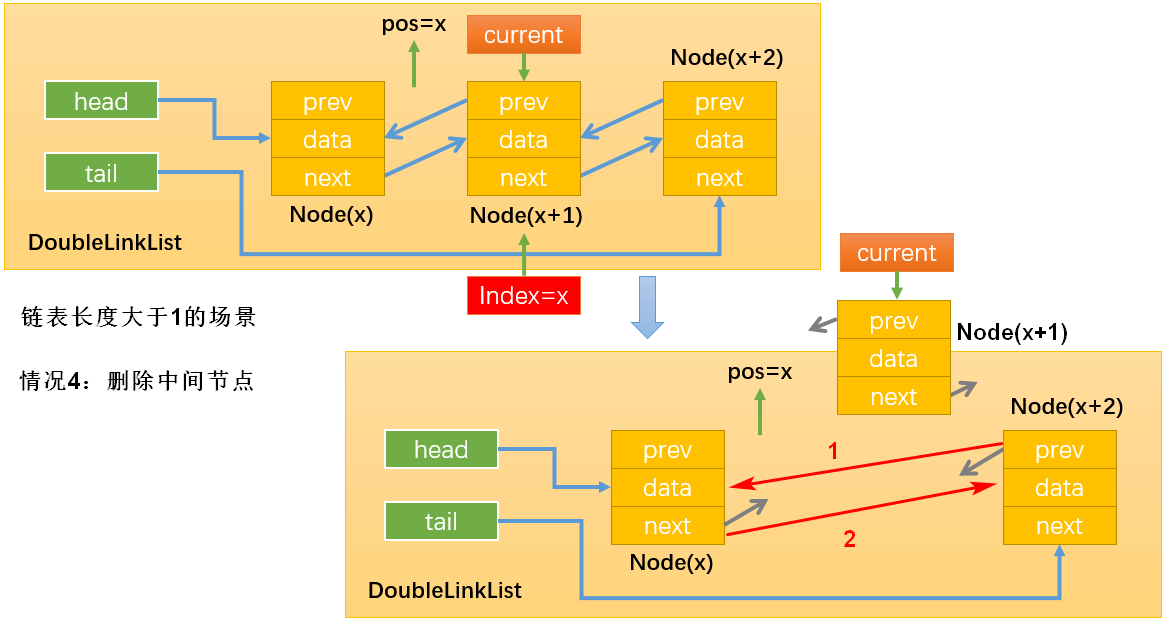
测试代码
// 已有:mmm aaa nnn bbb ccc 300
console.log(list.removeAt(0)) // mmm
console.log(list.toString()) // aaa nnn bbb ccc 300
// 已有:aaa nnn bbb ccc 300
console.log(list.removeAt(3)) // ccc
console.log(list.toString()) // aaa nnn bbb 300
8、remove|isEmpty|size 方法
// 8. remove方法:从列表移除一项
DoubleLinkList.prototype.remove = function (data) {
// 8.1 根据data获取下标值
var index = this.indexOf(data)
// 8.2 根据index 删除对应位置的节点
return this.removeAt(index)
}
// 9. isEmpty方法:为空返回true,不为空返回false
DoubleLinkList.prototype.isEmpty = function () {
return this.length === 0
}
// 10. size方法:返回节点个数
DoubleLinkList.prototype.size = function () {
return this.length
}
测试代码
// 8. 测试remove方法
// 已有:aaa nnn bbb 300
console.log(list.remove("nnn")) // nnn
console.log(list.toString()) // aaa bbb 300
// 已有:aaa bbb 300
// 9. 测试isEmpty方法
console.log(list.isEmpty()) // false
// 10. 测试size方法
console.log(list.size()) // 3
9、getHead|getTail 方法
// 11. 获取链表的第一个元素
DoubleLinkList.prototype.getHead = function () {
return this.head.data
}
// 12. 获取链表的最后一个元素
DoubleLinkList.prototype.getTail = function () {
return this.tail.data
}
测试代码
// 已有:aaa bbb 300
// 11. 测试getHead方法
console.log(list.getHead()) // aaa
// 12. 测试getTead方法
console.log(list.getTail()) // 300
10、完整代码
// 创建双向链表的构造函数
function DoubleLinkList() {
// 内部类:节点类
function Node(data) {
this.data = data
this.prev = null
this.next = null
}
// 属性
this.head = null // 用于指向第一个节点
this.tail = null // 用于指向最后一个节点
this.length = 0 // 记录长度
/* 常见方法 */
// 1. 将链表转存字符串形式
// 1.1 toString方法-从前往后遍历
DoubleLinkList.prototype.toString = function () {
return this.backwardString()
}
// 1.2 forwardString方法: 返回向前遍历节点字符串形式
DoubleLinkList.prototype.forwardString = function () {
// (1) 定义变量
var current = this.tail
var resultString = ""
// (2) 依次向前遍历,获取每一个节点
while (current) {
resultString += current.data + " "
current = current.prev
}
return resultString
}
// 2.3 backwardString方法: 返回向后遍历的节点的字符串形式
DoubleLinkList.prototype.backwardString = function () {
// (1) 定义变量
var current = this.head
var resultString = ""
// (2) 依次向后遍历,获取每一个节点
while (current) {
resultString += current.data + " "
current = current.next
}
return resultString
}
// 2. append方法
DoubleLinkList.prototype.append = function (data) {
// 2.1 根据元素创建节点
var newNode = new Node(data)
// 2、判断是否为第一个节点
if (this.head == null) {
// 情况1:添加的是第一个节点
this.head = newNode
this.tail = newNode
} else {
// 情况2:添加的不是第一个节点
newNode.prev = this.tail // 新节点prev指向当前最后一个
this.tail.next = newNode // 当前最后一个节点的next指向新节点
this.tail = newNode // 改变最后一个节点
}
// 2.3 length+1
this.length++
}
// 3. insert方法:向特定位置插入一个新的数据
DoubleLinkList.prototype.insert = function (position, data) {
// 3.1 边界判断
if (position < 0 || position > this.length) return false
// 3.2 根据data创建新的节点
var newNode = new Node(data)
// 3.4 判断原来的列表是否为空
if (this.length == 0) {
// 情况1:原链表为空,插入的newNode是第一个节点
this.head = newNode
this.tail = newNode
} else {
// 已有节点分多钟情况
if (position == 0) {
// 情况2:position == 0,插入第一个
this.head.prev = newNode
newNode.next = this.head
this.head = newNode
} else if (position == this.length) {
// 情况3:position == this.length,插入最后一个
newNode.prev = this.tail
this.tail.next = newNode
this.tail = newNode
} else {
// 情况4:0 < position < this.length,插入中间
var current = this.head
var index = 0
while (index++ < position) {
current = current.next
}
// 修改position位置前后节点的指针的指向
newNode.next = current
newNode.prev = current.prev
current.prev.next = newNode
current.prev = newNode
}
}
// 3.5 length +1
this.length += 1
// 返回插入成功
return true
}
// 4. get方法:获取对应位置的元素
DoubleLinkList.prototype.get = function (position) {
// 4.1 越界判断
if (position < 0 || position >= this.length) return null
// 4.2 获取元素
/*
方法一:一次查找,效率不是很高
var current = this.head
var index = 0
while (index++ < position) {
current = current.next
}
*/
/* 方法二:二分查找 */
var current = null
var index = 0
// this.length / 2 > position:从头开始遍历
if (this.length / 2 > position) {
current = this.head
while (index++ < position) {
current = current.next
}
} else {
// this.length / 2 <= position: 从尾开始遍历
current = this.tail
index = this.length - 1
while (index-- > position) {
current = current.prev
}
}
// 4.3 返回对应data
return current.data
}
// 5. indexOf方法:返回元素在列表中的索引,如果列表中没有该元素则返回-1
DoubleLinkList.prototype.indexOf = function (data) {
// 5.1 定义变量
var current = this.head
var index = 0
// 5.2 查找和data相同的节点
while (current) {
if (current.data == data) {
return index
}
current = current.next
index += 1
}
// 5.3 查找到最后也没找到对应的元素,返回-1
return -1
}
// 6. update方法:修改某个位置的元素
DoubleLinkList.prototype.update = function (position, newData) {
// 6.1 越界判断
if (position < 0 || position >= this.length) return false
// 6.2 查找正确的节点
var current = this.head
var index = 0
// 这里使用依次循环遍历,也可以使用二分查找
while (index++ < position) {
current = current.next
}
// 6.3 修改找到节点的data信息
current.data = newData
return true
}
// 7. removeAt方法:从特定位置移除一项
DoubleLinkList.prototype.removeAt = function (position) {
// 7.1 越界判断
if (position < 0 || position >= this.length) return null
// 7.2 判断是否只有一个节点
// 定义在最上面方便以下各种情况返回current.data
var current = this.head
if (this.length === 1) {
// 情况1:表只有一个节点
this.head = null
this.tail = null
} else {
// 链表节点不止一个的情况
if (position === 0) {
// 情况2:删除第一个节点
this.head.next.prev = null
this.head = this.head.next
} else if (position === this.length - 1) {
// 情况3:删除最后一个节点
// 先获取引用,该情况下返回被删除的最后一个节点
current = this.tail
// 再改变指针
this.tail.prev.next = null
this.tail = this.tail.prev
} else {
// 情况4:删除链表中间的节点
var index = 0
while (index++ < position) {
current = current.next
}
current.prev.next = current.next
current.next.prev = current.prev
}
}
// 7.3 length - 1
this.length -= 1
// 7.4 返回被删除节点的数据
return current.data
}
// 8. remove方法:从列表移除一项
DoubleLinkList.prototype.remove = function (data) {
// 8.1 根据data获取下标值
var index = this.indexOf(data)
// 8.2 根据index 删除对应位置的节点
return this.removeAt(index)
}
// 9. isEmpty方法:为空返回true,不为空返回false
DoubleLinkList.prototype.isEmpty = function () {
return this.length === 0
}
// 10. size方法:返回节点个数
DoubleLinkList.prototype.size = function () {
return this.length
}
// 11. 获取链表的第一个元素
DoubleLinkList.prototype.getHead = function () {
return this.head.data
}
// 12. 获取链表的最后一个元素
DoubleLinkList.prototype.getTail = function () {
return this.tail.data
}
}
// 0.创建双向链表对象
var list = new DoubleLinkList()
// 1.测试append方法:追加元素
list.append("aaa")
list.append("bbb")
list.append("ccc")
console.log(list)
// 2.测试字符串方法
console.log(list.forwardString()) // ccc bbb aaa
console.log(list.backwardString()) // aaa bbb ccc
console.log(list.toString()) // aaa bbb ccc
// 3.insert方法测试
// 已有:aaa bbb ccc
list.insert(0, "100") // 首部插入
list.insert(2, "200") // 中间插入
list.insert(5, "300") // 尾部插入
console.log(list.toString()) // 100 aaa 200 bbb ccc 300
// 4.get方法测试
// 已有:100 aaa 200 bbb ccc 300
console.log(list.get(0)) // 100
console.log(list.get(2)) // 200
console.log(list.get(5)) // 300
// 5.indexOf方法测试
// 已有:100 aaa 200 bbb ccc 300
console.log(list.indexOf("100")) // 0
console.log(list.indexOf("200")) // 2
console.log(list.indexOf("300")) // 5
// 6. 测试update方法
// 已有:100 aaa 200 bbb ccc 300
list.update(0, "mmm")
list.update(2, "nnn")
console.log(list.toString()) // mmm aaa nnn bbb ccc 300
// 7. 测试removeAt方法
// 已有:mmm aaa nnn bbb ccc 300
console.log(list.removeAt(0)) // mmm
console.log(list.toString()) // aaa nnn bbb ccc 300
// 已有:aaa nnn bbb ccc 300
console.log(list.removeAt(3)) // ccc
console.log(list.toString()) // aaa nnn bbb 300
// 8. 测试remove方法
// 已有:aaa nnn bbb 300
console.log(list.remove("nnn")) // nnn
console.log(list.toString()) // aaa bbb 300
// 已有:aaa bbb 300
// 9. 测试isEmpty方法
console.log(list.isEmpty()) // false
// 10. 测试size方法
console.log(list.size()) // 3
// 11. 测试getHead方法
console.log(list.getHead()) // aaa
// 12. 测试getTead方法
console.log(list.getTail()) // 300